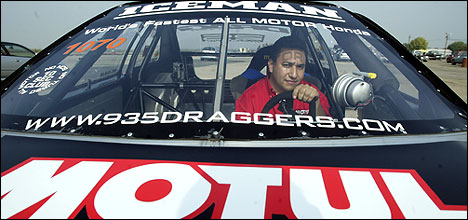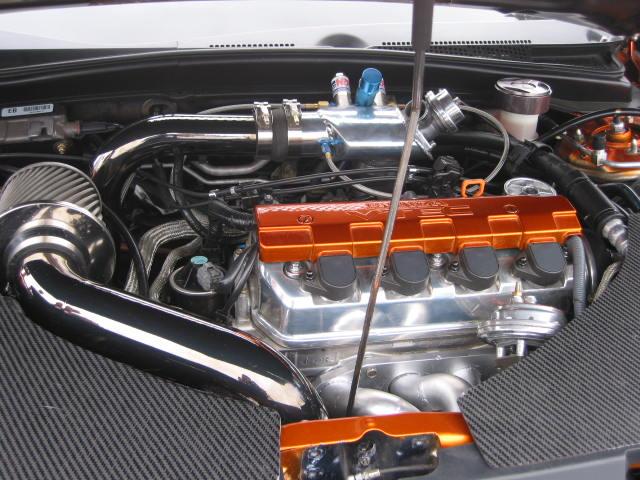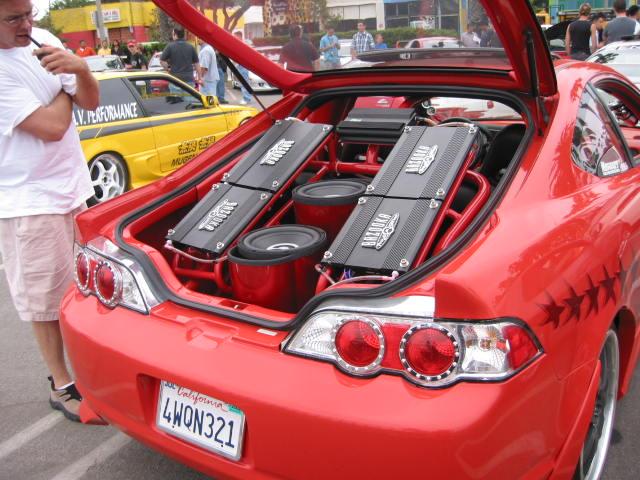
|
register register and you will receive urban-cachet announcements |
 On a smoggy afternoon on a broad swath of farmland in Bakersfield, Calif., Erick Aguilar is about to test years of work. He has brought a black Honda Civic to the Famoso Dragstrip to race against a small fleet of other souped-up imports, including tricked-out Mazda RX-7's and scorching fast vintage VW bugs. In the bleachers, a diverse crowd of young men and women have gathered to compare notes and watch the races, called the Battle of the Imports.
On a smoggy afternoon on a broad swath of farmland in Bakersfield, Calif., Erick Aguilar is about to test years of work. He has brought a black Honda Civic to the Famoso Dragstrip to race against a small fleet of other souped-up imports, including tricked-out Mazda RX-7's and scorching fast vintage VW bugs. In the bleachers, a diverse crowd of young men and women have gathered to compare notes and watch the races, called the Battle of the Imports.Mr. Aguilar lines up with another Civic, and when the light goes green, the 300 horsepower under his hood makes the car rocket off the starting line. It reaches 60 miles per hour in about three seconds and clears the quarter-mile in 10.28 seconds, with a top speed of 128 m.p.h.The crowd roars, and the crew at the starting line stands slack-jawed. Mr. Aguilar's little car has just become the fastest non-turbocharged, gasoline-powered Honda Civic on the planet. Back at the pits, Mr. Aguilar is humble. "We did a little work to broaden the horsepower," he said. "I guess it paid off." The work to which he refers includes plenty of old-fashioned greasy mechanical tinkering of the kind practiced by hot rodders and shade-tree mechanics for decades. But Mr. Aguilar is also a wizard at a newer sort of garage alchemy: the reprogramming of automotive engine control units, the small computers that regulate fuel, air and ignition, for maximum horsepower. Over the last decade or so, a generation of young, technologically smart drivers came to realize that if an engine control unit were simply a computer, then it could be hacked. They would not need a wrench to make their cars run faster; a keyboard and some patience would allow them to create customized high-performance engine-control programs of their own. The new generation of street racer  The result has been a revolution in high-tech hot rodding that has spread from Southern California to the East Coast and spawned a new market for performance-boosting add-on parts, gadgets and software. According to Jim Spoonhower, a spokesman for the Specialty Equipment Market Association, an industry group, sales of such aftermarket performance gear came to $2 billion in 2002, compared with $295 million in 1997. The result has been a revolution in high-tech hot rodding that has spread from Southern California to the East Coast and spawned a new market for performance-boosting add-on parts, gadgets and software. According to Jim Spoonhower, a spokesman for the Specialty Equipment Market Association, an industry group, sales of such aftermarket performance gear came to $2 billion in 2002, compared with $295 million in 1997.As Grant Downing, 40, who works for Venom Performance, a seller of high-tech car products in Stanton, Calif., said: "Kids these days, they go to school and they've got computers they learn on. That their car is also a computer is just no big deal to them." Venom fields an import drag-racing team and runs a Honda Civic whose 800-horsepower four-cylinder engine boasts both nitrous oxide injection and a turbocharger. The company produces various products for imported and domestic hot rods. But Wes Lakey, the company's director, says it is the sport import and compact market, cars that include the Civic, the Mitsubishi Eclipse, the Hyundai Tiburon, the VW Golf and even the surprisingly popular Ford Focus, that is growing fastest. "It's just exploded," Mr. Lakey said. "Small performance shops are just popping up everywhere." Introduction of nitrous oxide One of the computer products in which Venom takes most pride is a nitrous oxide injection system controlled by a Palm organizer. Once a mysterious gas known as much for blowing up engines as making them go faster, the horsepower-enhancing ability of nitrous oxide, or laughing gas, gained wide credibility in 2001 when the film "The Fast and the Furious" shone a spotlight on high-tech (and highly illegal) street racing. "The Palm Pilot piggybacks off your E.C.U.," Mr. Lakey said, referring to the engine control unit. "Instead of using your PC, now you can sit in your car and change your whole system. The Palm Pilot has all your engine configurations. You can set it to full race mode in seconds." Mr. Lakey said that the company came up with the product not only for convenience, but also because it is a great marketing tool. "A kid wants to be able to say, 'I can program my car with a Palm Pilot.' "  Engine control units first appeared in cars in the late 1970's. By regulating fuel injection, air and ignition far better than older systems that relied on carburetors and distributors, the E.C.U. resulted in better gas mileage and fewer emissions. These "black boxes" are now so advanced that a mechanic can diagnose it by simply plugging the car into a computer. Engine control units first appeared in cars in the late 1970's. By regulating fuel injection, air and ignition far better than older systems that relied on carburetors and distributors, the E.C.U. resulted in better gas mileage and fewer emissions. These "black boxes" are now so advanced that a mechanic can diagnose it by simply plugging the car into a computer.But for some, this technology came at a price. Until engine control units came along, all the small-time hot rodder needed to soup up an engine was a little knowledge, a few familiar tools and a well-tuned ear. By making such inexact science impossible, the E.C.U. relegated a proud band of do-it-yourself craftsmen to working only on older cars. With newer cars, most home mechanics were limited to mundane tasks like changing the oil or the spark plugs. For young people comfortable with technology, however, the increasing sophistication of engines has provided opportunities and challenges."I think young people have gotten back a love of cars," Mr. Spoonhower said. "They've grown up with technology and have learned that in some cases, they can work with the onboard computer systems to get a lot more performance." Mr. Downing said he was often amazed by how comfortable many younger mechanics are with computers and other electronic technology. Today, if a car halfway across the country is set up on a dynamometer - a device for measuring engine performance - and the data is sent out over the Internet, the engine can be analyzed and tuned remotely. "For old hot rodders like us, that sort of thing took some getting used to," he said, "but the young people just say, 'Of course you can do that.' " "I think young people have gotten back a love of cars," Mr. Spoonhower said. "They've grown up with technology and have learned that in some cases, they can work with the onboard computer systems to get a lot more performance." Embracing technology Mr. Downing said he was often amazed by how comfortable many younger mechanics are with computers and other electronic technology. Today, if a car halfway across the country is set up on a dynamometer - a device for measuring engine performance - and the data is sent out over the Internet, the engine can be analyzed and tuned remotely. "For old hot rodders like us, that sort of thing took some getting used to," he said, "but the young people just say, 'Of course you can do that.'  Mr. Aguilar, 31, is one of those younger mechanics with a lot of technological expertise. He did much of the work on his Honda at Church Automotive, a small performance garage in the blue-collar Los Angeles suburb of Hawthorne, (the birthplace of the Beach Boys). On a recent weekday, a couple of Mr. Aguilar's associates and racing partners were at work at the garage. Mr. Aguilar, 31, is one of those younger mechanics with a lot of technological expertise. He did much of the work on his Honda at Church Automotive, a small performance garage in the blue-collar Los Angeles suburb of Hawthorne, (the birthplace of the Beach Boys). On a recent weekday, a couple of Mr. Aguilar's associates and racing partners were at work at the garage.Shawn Church, the owner of Church Automotive, and Matt Wilimizig of Hondata, a company in nearby Torrance that designs high-performance replacement chips for Honda engine control units, had plugged a laptop computer into a 1992 Honda Civic hatchback owned by Alex Rascon, 24. The car was also hooked up to a dynamometer wired to its own PC. With its wide racing wheels, Mr. Rascon's Civic looked like a stock model. That is, until he raised the hood to reveal a shiny new custom-built 2-liter racing engine. He beheld his power plant as proudly as the owner of a Pontiac GTO might have regarded his 400-horsepower, 6-liter V-8 in 1970. "My motor is just high compression," he said, "no add-ons. I want to be able to take out the guys running nitrous oxide and turbos." Mr. Church and Mr. Wilimizig were there to help him by figuring out what kind of alterations to the E.C.U. would yield more engine power. "We can completely change this engine, optimizing the power over the whole r.p.m. range," said Mr. Church. "Ten years ago, you couldn't have done this." Because Honda has no interest in seeing its chips altered, the knowledge acquired by these E.C.U. hackers does not come easily. Most regular computer hackers can easily obtain the code embedded in a chip by using a common Windows or Unix interface. But the people at Hondata and other companies that specialize in modifying E.C.U.'s have to figure out how the millions of zeroes and ones in a chip actually control the engine. "You have to turn those numbers into human readable code and figure out what that code does," said Doug Macmillan of Hondata.  That can involve a lot of trial and error. Mr. Aguilar, who runs his own performance garage and has a background in electronics, spent thousands of hours decoding the data to write a DOS-based program that let him reprogram Honda chips. The people at Hondata went one step further and wrote a Windows program that created 3-D maps of how fuel, air and timing interact. That can involve a lot of trial and error. Mr. Aguilar, who runs his own performance garage and has a background in electronics, spent thousands of hours decoding the data to write a DOS-based program that let him reprogram Honda chips. The people at Hondata went one step further and wrote a Windows program that created 3-D maps of how fuel, air and timing interact.These programs allow mechanics to test various settings while a car is hooked up to the dynamometer. After the peak performance settings are obtained, they can then produce a replacement chip for the car (using programmable ROM chips) that will produce the same results permanently. With Mr. Rascon's Civic howling away on the dynamometer, Mr. Wilmizig adjusted air and fuel mixtures on his laptop while Mr. Church read out continually increasing horsepower numbers. Mr. Church figured that the Civic would be good for 220 horsepower and would be able to run the quarter-mile in just over 12 seconds, about as fast as a new $73,000 Dodge Viper or a $115,000 Porsche 911 Turbo would. Mr. Rascon paid only $8,000 for his Honda. "It's amazing," Mr. Rascon said. "With fuel pressure regulators and a few other things you could get maybe 5 or 10 more horsepower, but with this, it's maybe 30 just by making everything work together." Honda rules the road  With the Honda tested and tuned, he disappeared from the garage in a cloud of tire smoke. "These small cars appeal to a new generation of kids who are very technologically savvy," Mr. Church said. Although he sees many makes of cars in his shop, he said, Hondas are the most popular among hot rodders today. "They've always built efficient, high-tech cars,'' he said. "But I think the real genius was that they designed things to be easy to replace, easy to modify, and they always leave room in their engines for more power."
With the Honda tested and tuned, he disappeared from the garage in a cloud of tire smoke. "These small cars appeal to a new generation of kids who are very technologically savvy," Mr. Church said. Although he sees many makes of cars in his shop, he said, Hondas are the most popular among hot rodders today. "They've always built efficient, high-tech cars,'' he said. "But I think the real genius was that they designed things to be easy to replace, easy to modify, and they always leave room in their engines for more power."Back at Hondata, a clearly pleased Mr. Rascon went over the final numbers on his car with Mr. Macmillan. "My mom says to me, 'Why are you doing this?' " he said. " 'I'm sick and tired of it. Let's go buy you a new 350Z or Lexus and I'll help you with payments.' " But Mr. Rascon is sure he does not want a Lexus or a Nissan 350Z. "You get a Lexus or 350Z, and, sure, people will look at you, but that's now what this is about," he said. "This is about getting into something I built and whipping a 350Z. That's the best feeling in the world." |
|
| ride | music | horoscopes | vastu | food | art | games | urban mystic |
© 2000 - 2009 urban-cachet inc. all rights reserved